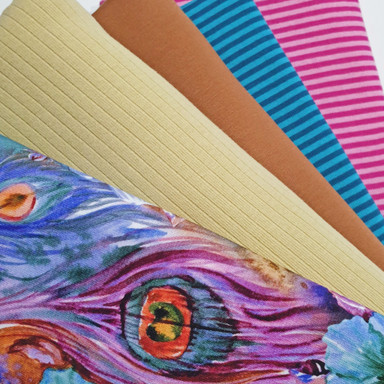Posted by Wicked Fabrics - Vivi Richards on 22nd Mar 2023
Introduction: Knit Fabrics - What You Need To Know About Jersey, Interlock and Rib Knit
Read Time: 5m
Now that you know more about fabric via my previous blog post, you know choosing the right knit fabric can make all the difference between a successful outcome and a disaster. Whether you're a seasoned knit sewer or just starting out, let's dive a beyond the surface and learn a little more about jersey, interlock and rib knit fabric.
Jersey Knit
Jersey knit fabric is one of the more popular choices for sewers looking for lightweight, stretchy material for apparel.
It is a type of knit fabric that is created by looping yarns together. It has a distinct knit structure that creates a stretchy, flexible, and comfortable fabric. You can make t-shirts, leggings, shorts and underwear from jersey knit fabric and it comes in a variety of fibres including cotton, modal, viscose, bamboo, polyester, rayon, and blends.
Jersey knit fabric can be found in many fabric stores and online. Look for high-quality OEKO-TEX 100 or GOTS certified fabrics if you care about honest manufacturing and sustainability. With it's popularity you can find a variety of prints and colours to add a unique touch to your project.
Why Jersey Knit Fabric?
Sewers looking for a fabric to create lightweight and comfortable apparel should consider jersey knit fabric. Jersey knit fabric is easy to sew with, making it a great choice for beginners and experienced sewers alike.
Features of Jersey Knit
- Stretchy and flexible
- Soft and comfortable
- Durable and long-lasting
- Breathable and moisture-wicking
- Easy to care for and maintain
Jersey knit fabric comes in a variety of composition and blends. 100% cotton is the most common type of jersey knit, however, as technology advances we are finding more options available to cater to different markets and requirements. An example of this is cotton elastane (also known as cotton lycra or cotton spandex), this composition has become increasing popular over the last decade. Jersey in general is the go-to for most apparel projects as there's so many fabric options and can be layered making it suitable all year.
Interlock Knit
Interlock knit is a type of knitted fabric that is made up of two layers of interlocked yarns. This double-knit fabric is heavier than jersey knit making it just as versatile and durable, it is a popular choice for making heavier items of apparel, such as polo shirts, dresses, and pants. It is also a great choice for making baby clothes, blankets and any apparel that is required to be comfortable and stylish.
There are several different types of interlock knit fabric available. Cotton interlock is a popular choice for its breathability and softness. Polyester interlock is a durable fabric that is resistant to wrinkles and fading however, the least environmentally friendly. Bamboo interlock is a lightweight, eco-friendly option that is also moisture-wicking.
Examples of interlock knit fabrics include cotton interlock, polyester interlock, bamboo interlock and other blends.
Features of Interlock Knit Fabric
- Durability - Interlock knit fabric is extremely durable and can withstand regular wear and tear. This makes it an ideal choice for sewers who are looking for a fabric that will last for years. The tight knit construction of the fabric makes it resistant to tearing and snagging, which is a great benefit for anyone who wants to make garments that are durable and long-lasting. Interlock knit fabric also has an inherent level of wrinkle resistance, which makes it ideal for sewing garments that need to maintain their shape and look good for a long time. This is especially useful for clothing items that require frequent washing, such as uniforms or garments that are frequently worn in hot, humid climates.
- Versatility - Interlock knit fabric is highly versatile and can be used to create a wide range of garments. This is because the fabric is easy to work with and comfortable to wear. It can be dyed, printed, and embroidered, which makes it a great choice for sewers who want to add their own unique touches to their creations.
- Breathability - Interlock knit fabric made out of natural fibre is highly breathable, making it a great choice for garments that need to keep the wearer cool and comfortable. This is important for items of clothing that are worn in hot climates or during physical activities, such as sports uniforms or workout clothes. The fabric is naturally moisture-wicking, which helps to keep the wearer comfortable.
Rib Knit
Rib knit fabric is a type of knitted fabric that has been knitted in a way so that it has a visual and textural "ribbed" hand feel. This type of fabric is made by interweaving two sets of yarns in alternating directions. This creates a pattern of ridges and columns that resemble the "ribs".
Rib knit fabric is highly elastic and flexible, making it an ideal choice for a variety of projects. It is durable, which makes it perfect for clothing and other items that require frequent wear. It is often used to make apparel from tops to leggings and sewers are finding more ways to use it.
Rib knit fabric is versatile, as it can be used in a variety of ways. When used for garments, rib knit fabric is great for creating a snug and comfortable fit, it is also a popular choice of fabric for banded necklines, cuffs, and hem edges. Many like to use this fabric to make scarves and beanies and some like to work with this in a decorative nature to add texture to their projects.
Examples of rib knit fabrics include cotton rib, wool rib, bamboo rib, polyester rib and other blends.
Tips for Working With Knit Fabric
When working with knit fabric, it is important to be use the right tools to avoid disappointment. It'll save your sanity and you'll get a high quality finish.
Sewing with knit fabric can be tricky as it can stretch out when sewed. To avoid this, it’s important to use the right needle, have your machine set up correctly for knit fabric and the right sewing foot on your sewing machine if you are not using an overlocker. I find sewing knits using an overlocker with differential feed helps greatly however, if you are using a sewing machine be sure to use the right stitch and stitch length (you want to use a slightly longer stitch) and tension.
Finally, if you find your knit has stretched slightly during the sewing process use a steam iron on low to press your fabric and it'll help it return to shape.
Don't be afraid to ask questions and be adventurous!
We all learn through trial and error and sometimes even mistakes can be blessings in disguise. By taking the time to step out of our comfort zones and be open to the possibilities, we can find new ways to work with fabric and take our projects to the next level. It’s time to take a chance and be creative - you never know what you’re capable of until you try!


